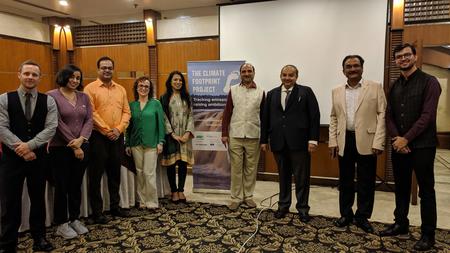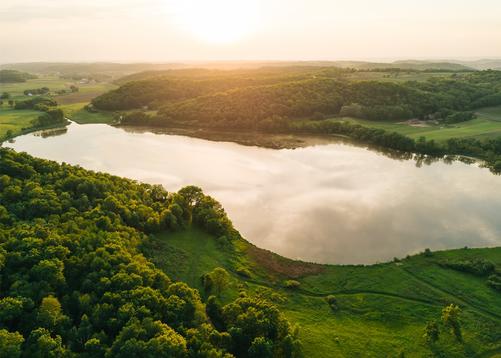Tracking greenhouse gas emissions at the state level is at the core of achieving the objectives of the State Action Plans on Climate Change by Indian states
Since 2018, the Climate Footprint Project has been supporting state and regional governments to improve their greenhouse gas (GHG) emissions tracking and reduction efforts. In the first phase of the project, it worked with states and regions in developing and newly industrialising countries, including Pernambuco (Brazil), Chhattisgarh and West Bengal (India), Baja California, Jalisco and Yucatán (Mexico) and KwaZulu-Natal (South Africa).
The work in India
Regional greenhouse gas inventories provide the level of detail needed to allow local policymakers to understand their emissions sources and trends to enhance the design of their emissions reduction strategies. In India, the project supported two Under2 Coalition member states, Chhattisgarh and West Bengal, in strengthening their knowledge and understanding on tracking sectoral emissions and developing state-level GHG inventories, which provide a foundation for undertaking robust mitigation efforts and policymaking.
In both states, support was provided over the course of the project through a combination of in-person meetings, interviews and remote-technical assistance by Ricardo Energy & Environment and India implementing partner The Energy and Resources Institute (TERI) in coordination with Climate Group. An easy to use toolbox containing GHG inventory compilation manuals and relevant templates were provided to guide their environmental or climate change teams on how to compile an economy-wide GHG inventory. This was supplemented with a package of additional resources through technical guidance notes and recorded webinars.
In Chhattisgarh, the project was implemented with support from three key local organisations. It was delivered through the Chhattisgarh State Centre on Climate Change (CSCCC) in coordination with and supported by state departments and other agencies. Chhattisgarh Council of Science and Technology (CCOST) acted as the knowledge partner and Chhattisgarh Renewable Energy Development Agency (CREDA) supported key state-specific energy data. By the end of the project, draft inventories for the energy and agriculture sectors were prepared and submitted to the government for future use beyond recorded technical webinars and other materials.
Similarly, in West Bengal, the Department of Environment was the lead government partner for the project. Alongside the remote technical assistance of the project, an initial draft inventory for the Agriculture, Forestry and Other Land Use (AFOLU) sector was developed for West Bengal, following IPCC guidelines. The project has equipped the state team with a technical understanding of the steps involved in compiling an inventory, which can now be used to develop inventories for other sectors.
“The Climate Footprint Project has established live linkage between key institutions such as the State Climate Change Centre, CCOST and CREDA. The template for regional Measurement, Reporting and Verification (MRV) systems has been tuned to the national efforts and included local needs. This GHG emission inventory shall help the administrators to identify the opportunities to establish climate mitigation goals at the state level and allow fine-tuning of policy/execution design in times to come.
As an extension to this GHG emission inventory data collection, it would be worthwhile to validate the estimated GHG data for pilot sites by establishing field instrumentation for continuous monitoring of GHG emissions. CCOST may support the implementation of such a pilot study.”
“The Climate Footprint Project has established live linkage between key institutions such as the State Climate Change Centre, CCOST and CREDA. The template for regional Measurement, Reporting and Verification (MRV) systems has been tuned to the national efforts and included local needs. This GHG emission inventory shall help the administrators to identify the opportunities to establish climate mitigation goals at the state level and allow fine-tuning of policy/execution design in times to come.
As an extension to this GHG emission inventory data collection, it would be worthwhile to validate the estimated GHG data for pilot sites by establishing field instrumentation for continuous monitoring of GHG emissions. CCOST may support the implementation of such a pilot study.”

The project also provided additional capacity building and peer learning opportunities to the states in the form of a peer-to-peer webinar with KwaZulu-Natal (South Africa) in March 2021 and a peer forum in May 2021. In these forums, both states shared their work with other Indian states, civil society organisations and NGOs, and European members of the Under2 Coalition. The project e-learning course on ‘The Basics of Subnational GHG Accounting’ undertaken by Chhattisgarh and West Bengal officials further strengthened their understanding of emissions tracking and accounting methods.
Another significant component of the project included establishing more substantial alignment across different levels of government in the project countries. As part of this, two Multi-Level Governance Dialogues were organised, which brought representatives from the national, state and city/municipal levels in India, including civil society organisations, to discuss ways to enable vertical integration for improving the current MRV arrangements in India. Among several topics covered in these convenings, the need for more robust data aggregation, transparency, inter-departmental coordination at the state level, an institutional framework on GHG inventories and greater involvement of academic institutions and civil society organisations were identified.
A challenging period
2020 – 2021 has been a difficult period for the world, and India was no exception. Just as project groundwork in India had been established, the COVID-19 pandemic restricted engagement with Chhattisgarh and West Bengal. Not only did in-person workshops became impossible, but the governments of both states had to attend to the crisis while dealing with technological barriers to continue their work. Following the initial period of the pandemic in 2020, other events shook the states, including two tropical cyclones, Amphan and Yaas, hitting West Bengal in May 2020 and May 2021, respectively. The second wave of COVID-19 - described as a ‘tsunami’ - shook the country from April 2021.
Despite these formidable challenges, Climate Group and the partner organisations and state governments were able to continuously make progress and offer remote technical support to both states to build resilient systems.
The way forward
There are significant efforts at crucial levels of government in India to develop robust MRV systems. For example, several national programmes and schemes have a dedicated M&E system for tracking financial and implementation parameters. However, India has yet to establish an integrated MRV framework to track GHG emissions and state-level mitigation actions.
Several states and cities in India are undertaking voluntary and mandated climate actions and initiatives, but a unified operational mechanism to track their progress is still missing. There is also a need to strengthen understanding of MRV and GHG inventories at the state level through concerted efforts. Projects such as the Climate Footprint Project, which seek to address this pertinent challenge by engaging various levels of government, can act as a game-changer in India.
Indian states are revising their State Action Plans on Climate Change (SAPCC), detailing their medium to long-term climate strategies. Additionally, we are witnessing a growing global momentum on the call for governments to raise ambition in this critical decade. Considering these developments, a strong foundation of emissions tracking mechanisms at the state level is imperative for supporting both national and state governments in India to achieve their climate goals through designing pragmatic and data-driven policies.
